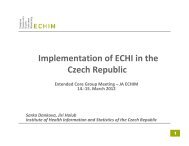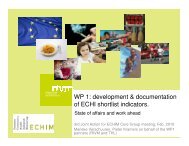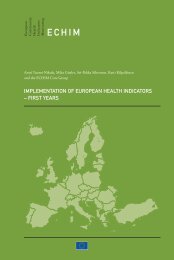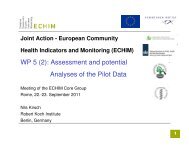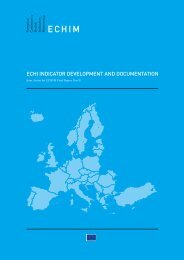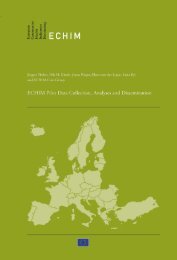INDICATORS
ECHIM Final Report
ECHIM Final Report
Create successful ePaper yourself
Turn your PDF publications into a flip-book with our unique Google optimized e-Paper software.
ANNEX 2: Documentation Sheets (short form) for the ECHI shortlist<br />
indicators<br />
1. POPULATION BY SEX/AGE<br />
Definition: Total population by country, broken down by sex and age. The total population<br />
of the country consists of all persons falling within the scope of the census.<br />
Calculation: Absolute numbers by sex, preferably presented at least by 10-year age bands<br />
0, 1–4, 5–14, 15–24, 25–34, 35–44, 45–54, 55–64, 65–74, 75–84, 85+ (ICD-10 optional<br />
recommendation with 85+ added, being the Eurostat grouping). Minimally presented by sex<br />
and by age groups 0–14, 15–44, 45–64, 65–84, 85+ (ICD-10 minimal recommendation,<br />
without the 1-year limit and with the 85+ limit added).<br />
1) Eurostat: Calculated as the number of inhabitants of a given area on 1 January of the year<br />
in question.<br />
2) (OECD: Data from Eurostat)<br />
3) WHO: Estimate of resident (de jure) population on 1 July of given calendar year. Usually,<br />
it is calculated as an average of end-year estimates.<br />
Both end of year and mid year populations (which can be calculated from the end of year<br />
figures) are needed for calculations of different indicators (prevalence and incidence).<br />
Notes: Both absolute numbers and percentages are needed. The latter can be calculated from<br />
the former. In the broadest sense, the total population may comprise either all usual residents<br />
of the country or all persons present in the country at the time of the census. The total of all<br />
usual residents is generally referred to as the de jure population and the total of all persons<br />
present as the de facto population.<br />
2. CRUDE BIRTH RATE<br />
Definition: Crude Birth Rate is defined as the number of all live births in a given year per<br />
mean population in the same year. Usually multiplied by 1000.<br />
Calculation: Eurostat: Number of all live births in a given year divided by the number of<br />
person-years lived by the population in the same period, expressed per 1000 persons.<br />
Notes: Instead of mean population also number of person-years lived by the population in<br />
the same period can be used as the denominator.<br />
3. MOTHER’S AGE DISTRIBUTION<br />
Definition: Age distribution of mothers, in years, at delivery.<br />
86




